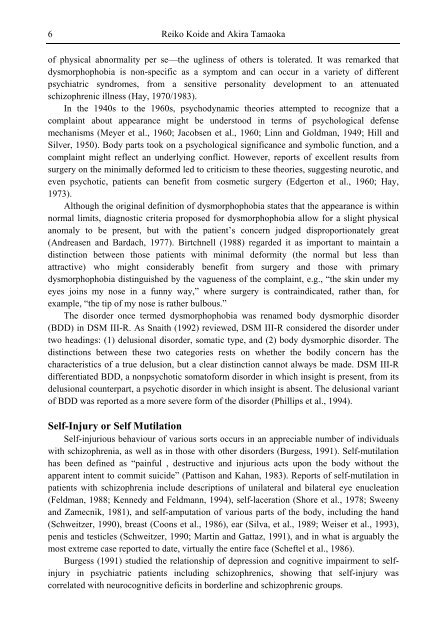Schizophrenia Research Trends
Schizophrenia Research Trends
Schizophrenia Research Trends
- No tags were found...
You also want an ePaper? Increase the reach of your titles
YUMPU automatically turns print PDFs into web optimized ePapers that Google loves.
6Reiko Koide and Akira Tamaokaof physical abnormality per se—the ugliness of others is tolerated. It was remarked thatdysmorphophobia is non-specific as a symptom and can occur in a variety of differentpsychiatric syndromes, from a sensitive personality development to an attenuatedschizophrenic illness (Hay, 1970/1983).In the 1940s to the 1960s, psychodynamic theories attempted to recognize that acomplaint about appearance might be understood in terms of psychological defensemechanisms (Meyer et al., 1960; Jacobsen et al., 1960; Linn and Goldman, 1949; Hill andSilver, 1950). Body parts took on a psychological significance and symbolic function, and acomplaint might reflect an underlying conflict. However, reports of excellent results fromsurgery on the minimally deformed led to criticism to these theories, suggesting neurotic, andeven psychotic, patients can benefit from cosmetic surgery (Edgerton et al., 1960; Hay,1973).Although the original definition of dysmorphophobia states that the appearance is withinnormal limits, diagnostic criteria proposed for dysmorphophobia allow for a slight physicalanomaly to be present, but with the patient’s concern judged disproportionately great(Andreasen and Bardach, 1977). Birtchnell (1988) regarded it as important to maintain adistinction between those patients with minimal deformity (the normal but less thanattractive) who might considerably benefit from surgery and those with primarydysmorphophobia distinguished by the vagueness of the complaint, e.g., “the skin under myeyes joins my nose in a funny way,” where surgery is contraindicated, rather than, forexample, “the tip of my nose is rather bulbous.”The disorder once termed dysmorphophobia was renamed body dysmorphic disorder(BDD) in DSM III-R. As Snaith (1992) reviewed, DSM III-R considered the disorder undertwo headings: (1) delusional disorder, somatic type, and (2) body dysmorphic disorder. Thedistinctions between these two categories rests on whether the bodily concern has thecharacteristics of a true delusion, but a clear distinction cannot always be made. DSM III-Rdifferentiated BDD, a nonpsychotic somatoform disorder in which insight is present, from itsdelusional counterpart, a psychotic disorder in which insight is absent. The delusional variantof BDD was reported as a more severe form of the disorder (Phillips et al., 1994).Self-Injury or Self MutilationSelf-injurious behaviour of various sorts occurs in an appreciable number of individualswith schizophrenia, as well as in those with other disorders (Burgess, 1991). Self-mutilationhas been defined as “painful , destructive and injurious acts upon the body without theapparent intent to commit suicide” (Pattison and Kahan, 1983). Reports of self-mutilation inpatients with schizophrenia include descriptions of unilateral and bilateral eye enucleation(Feldman, 1988; Kennedy and Feldmann, 1994), self-laceration (Shore et al., 1978; Sweenyand Zamecnik, 1981), and self-amputation of various parts of the body, including the hand(Schweitzer, 1990), breast (Coons et al., 1986), ear (Silva, et al., 1989; Weiser et al., 1993),penis and testicles (Schweitzer, 1990; Martin and Gattaz, 1991), and in what is arguably themost extreme case reported to date, virtually the entire face (Scheftel et al., 1986).Burgess (1991) studied the relationship of depression and cognitive impairment to selfinjuryin psychiatric patients including schizophrenics, showing that self-injury wascorrelated with neurocognitive deficits in borderline and schizophrenic groups.
















